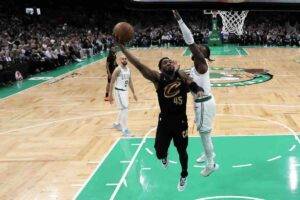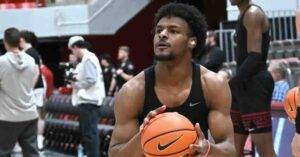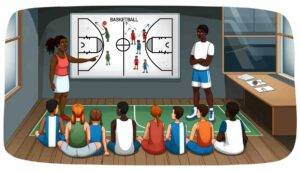The Boston Celtics' Defensive Strategy in Playoff Series against the Cleveland Cavaliers
The Boston Celtics' defensive strategy against the Cleveland Cavaliers focuses on limiting three-point shots by trapping near the basket. Al Horford plays a crucial role as a defensive anchor, shutting down opponents and protecting the Celtics' defense. The Celtics prioritize defending against two-point shots and utilize effective communication and coordination on defense. They make adjustments and adaptations based on the Cavaliers' offensive approach. #NBA #Celtics #defense

In the playoff series against the Cleveland Cavaliers, the Boston Celtics have implemented a smart defensive strategy centered around Al Horford. By luring the Cavaliers into the paint, the Celtics aim to limit their opponents' three-point shooting opportunities. Their goal is to trap the Cavaliers near the basket, making it harder for them to take easy three-point shots. This strategy has proved successful in the Celtics' third victory of the series. Horford's role as a second line of defense near the basket has been pivotal, as he effectively shuts down opponents and protects the Celtics' defense. The team's focus on defending against two-point shots rather than three-point shots is evident, and Horford serves as a key defensive anchor in this strategy.
The Importance of Al Horford in the Celtics' Defensive Strategy
When it comes to the Boston Celtics' defensive strategy, one player has played a crucial role in their success - Al Horford. The Celtics have been utilizing Horford's defensive skills to their advantage, making him an essential part of their overall game plan.
Utilizing Horford's Defensive Skills
Al Horford's defensive abilities have been instrumental in the Celtics' playoff series against the Cleveland Cavaliers. As a versatile player, Horford has shown his ability to guard different positions, making him a valuable asset on the court. His ability to contest shots, defend the paint, and switch onto smaller players makes him a formidable force.
Creating a Second Line of Defense near the Basket
One of the key ways the Celtics have been using Horford in their defensive strategy is by creating a second line of defense near the basket. Horford's presence near the rim has made it difficult for opposing teams to score easy baskets in the paint. His shot-blocking ability and overall defensive awareness have made him an effective deterrent for opponents looking to attack the basket.
Shutting Down Opponents near the Basket
Horford's ability to shut down opponents near the basket has been crucial for the Celtics' defensive success. His anticipation and positioning allow him to contest shots effectively and force opponents into difficult scoring situations. Whether it's contesting shots at the rim or defending against post-up plays, Horford's defensive prowess has been a game-changer for the Celtics.
Forcing Cleveland to Play Closer to the Basket
In their playoff series against the Cleveland Cavaliers, the Celtics have been focused on forcing their opponents to play closer to the basket. By doing so, they aim to limit the Cavaliers' opportunities for easy three-point shots and encourage their players to drive to the paint.
Limiting Opportunities for Easy Three-Point Shots
The Cavaliers are known for their three-point shooting ability, and the Celtics are well aware of the threat they pose. By forcing Cleveland to play closer to the basket, the Celtics limit the opportunities for easy three-point shots. This strategy disrupts the Cavaliers' offensive flow and forces them to find alternative ways to score.
Encouraging Cleveland's Players to Drive to the Paint
By pushing Cleveland's players to drive to the paint, the Celtics create a more crowded and congested defensive environment. This makes it harder for the Cavaliers to find open shooting lanes and forces them to navigate through a stronger Celtics defense. In turn, this increases the chances of defensive turnovers and contested shots near the basket.
Shorter Rebounds and Easier Defensive Rebounding
Another benefit of forcing Cleveland to play closer to the basket is that it leads to shorter rebounds that are easier for the Celtics to secure. With Horford's presence near the rim and the Celtics' overall defensive positioning, they are able to control the boards more effectively. This limits second-chance opportunities for the Cavaliers and allows the Celtics to gain possession and push the ball in transition.
Defending Against Three-Point Shooting
Given the Cavaliers' reputation as a strong three-point shooting team, the Celtics have placed a significant emphasis on defending against their long-range shots. They understand that limiting the Cavaliers' success from beyond the arc is crucial to their overall defensive strategy.
Cavaliers' Three-Point Shooting Threat
The Cavaliers boast several players who are threats from beyond the arc, such as LeBron James, Kevin Love, and J.R. Smith. These players have the ability to catch fire from three-point range and change the momentum of a game. The Celtics recognize the need to contain these key shooters and prevent them from getting into a rhythm.
Targeting Key Three-Point Shooters
To defend against the Cavaliers' three-point shooting threat, the Celtics have focused on targeting key shooters and denying them open looks. By closely guarding players like J.R. Smith and Kevin Love, the Celtics make it harder for them to find open shooting opportunities. This forces the Cavaliers to rely on less efficient scoring options and disrupts their offensive rhythm.
Using Traps to Deny Open Three-Point Shots
The Celtics have also utilized trapping techniques to deny the Cavaliers open three-point shots. By aggressively double-teaming or trapping ball handlers, the Celtics force quick, rushed passes that can disrupt the Cavaliers' three-point shooting rhythm. This tactical approach has proven effective in limiting the Cavaliers' success from beyond the arc.
Utilizing Trapping Techniques
Trapping techniques have been a key component of the Celtics' defensive strategy, and they have used them effectively against the Cavaliers. These techniques allow the Celtics to apply pressure on the Cavaliers' offense, create turnovers, and disrupt their offensive flow.
Implementing Traps near the Basket
One way the Celtics have implemented traps is by positioning their players near the basket. This positioning allows them to close off passing lanes and collapse on opposing players trying to score near the rim. By trapping opponents in this manner, the Celtics force difficult passes and increase the chances of turnover opportunities.
Forcing Cleveland Players into Difficult Passes
By implementing traps, the Celtics effectively force Cleveland players into difficult passes. This disrupts the Cavaliers' offensive rhythm and limits their ability to find open teammates for easy scoring opportunities. It also puts pressure on the opposing players, increasing the chances of turnovers and defensive stops for the Celtics.
Creating Turnover Opportunities
One of the main goals of the Celtics' trapping techniques is to create turnover opportunities. When the Cavaliers find themselves trapped or under pressure, their decision-making and passing can be compromised. The Celtics capitalize on these moments, using their defensive intensity to create turnovers and generate transition opportunities for their offense.
Limiting LeBron James' Impact near the Basket
LeBron James is known for his ability to dominate near the basket. He poses a significant threat to any defense with his scoring ability and playmaking skills. The Celtics understand the importance of limiting his impact and have developed strategies to defend against him effectively.
Double-Teaming LeBron James
One method the Celtics have employed in defending against LeBron James is double-teaming him. By sending an additional defender to guard him when he has the ball, the Celtics aim to make it harder for him to score and force him to give up the ball. This forces LeBron to rely on his teammates to create offense, which disrupts the Cavaliers' offensive flow.
Al Horford's Role in Defending against James
Al Horford has played a crucial role in defending against LeBron James. With his defensive versatility and ability to guard multiple positions, Horford has been tasked with defending James on several occasions. His combination of size, agility, and basketball IQ has made him an effective deterrent against LeBron's scoring attempts near the basket.
Preventing Easy Scoring Opportunities in the Paint
The Celtics' defensive strategy against LeBron James also involves preventing easy scoring opportunities in the paint. By positioning their players effectively and maintaining a strong defensive presence near the rim, the Celtics make it challenging for LeBron to score at the basket. This forces him to rely on jump shots and mid-range jumpers, which are generally less efficient scoring options for him.
The Celtics' Defensive Success in Game 3
In Game 3 of their playoff series against the Cleveland Cavaliers, the Celtics' defensive strategy paid off handsomely. Their effective execution of defensive strategies and overall defensive intensity led them to a convincing victory.
Effective Execution of Defensive Strategies
The Celtics executed their defensive strategies with precision and discipline in Game 3. From trapping techniques to double-teaming LeBron James, the Celtics showcased their defensive versatility and unity on the court. Their ability to disrupt the Cavaliers' offensive flow and prevent easy scoring opportunities was a testament to their defensive prowess.
Impacting Cleveland's Shooting Percentage
The Celtics' defensive efforts had a significant impact on the Cavaliers' shooting percentage in Game 3. By contesting shots, denying open looks, and applying defensive pressure, the Celtics limited the Cavaliers' shooting efficiency. This forced the Cavaliers into more difficult shots and led to a lower shooting percentage for the opposing team.
Minimizing Easy Scoring Opportunities
One of the key indicators of the Celtics' defensive success in Game 3 was their ability to minimize easy scoring opportunities for the Cavaliers. By shutting down open three-point shots and contesting shots near the rim, the Celtics made it challenging for the Cavaliers to score efficiently. This allowed the Celtics to maintain control of the game and secure a crucial victory.
Defending Two-Point Shots vs. Three-Point Shots
The Celtics' defensive strategy prioritizes defending against two-point shots over three-point shots. They recognize the need to limit high-percentage three-point shots and utilize Al Horford as a defensive anchor.
Prioritizing Defense against Two-Point Shots
The Celtics prioritize defending against two-point shots due to their higher probability of success compared to three-point shots. By focusing on preventing easy scoring opportunities near the basket, the Celtics increase the difficulty level for their opponents. This defensive mindset forces opposing teams to rely on less efficient shooting options.
Limiting High Percentage Three-Point Shots
The Celtics recognize the importance of limiting high-percentage three-point shots. By closely guarding opposing players and denying open looks from beyond the arc, the Celtics decrease the likelihood of their opponents finding success from long range. This defensive approach puts pressure on opposing shooters to take more difficult shots and lowers their shooting efficiency.
Using Horford as a Defensive Anchor
Al Horford's versatility and defensive abilities make him a key defensive anchor for the Celtics. His presence near the rim and ability to contest shots effectively gives the Celtics an advantage in defending against two-point shots. Horford's defensive contributions play a significant role in the Celtics' success in limiting high-percentage scoring opportunities for their opponents.
Communication and Coordination on Defense
Effective communication and coordination among the Celtics' players are essential elements of their defensive strategy. Working together as a cohesive unit allows the Celtics to close gaps, prevent easy drives, and maintain a strong defensive presence on the court.
Effective Communication among Celtics' Players
The Celtics' defensive success is partly attributed to their effective communication on the court. By constantly communicating with one another, the players are able to stay connected and aware of their defensive assignments. This facilitates better defensive rotations, timely help defense, and overall defensive cohesion.
Coordinated Defensive Rotations
Coordinated defensive rotations are crucial for the Celtics' defensive strategy to be effective. By rotating and shifting as a unit, the Celtics are able to close gaps, deny open passing lanes, and contest shots effectively. This coordinated effort disrupts opposing offenses and makes it harder for them to find scoring opportunities.
Closing Gaps and Preventing Easy Drives
The Celtics' defensive communication and coordination help them close gaps and prevent opposing players from driving to the basket easily. By working together and communicating effectively, the Celtics are able to anticipate and react to offensive movements quickly. This allows them to close driving lanes and force opponents into difficult scoring situations.
Adjustments and Adaptations in the Celtics' Defensive Strategy
The Celtics understand the importance of making adjustments and adaptations in their defensive strategy to counter Cleveland's offensive adjustments. By analyzing the Cavaliers' offensive approach, the Celtics are able to modify their trapping techniques and maintain flexibility in their defensive approach.
Analyzing Cleveland's Offensive Adjustments
To stay ahead of the game, the Celtics analyze Cleveland's offensive adjustments and adapt their defensive strategy accordingly. By studying the tendencies of the Cavaliers' players and identifying their offensive patterns, the Celtics are able to make strategic adjustments to counter their opponents effectively.
Modifying Trapping Techniques to Counter
The Celtics have shown a willingness to modify their trapping techniques as needed to counter their opponents' offensive adjustments. Whether it's adjusting the timing of their traps or altering their defensive rotations, the Celtics understand the importance of staying one step ahead. This flexibility allows them to disrupt opposing offenses and maintain control of the game.
Maintaining Flexibility in Defensive Approach
Maintaining flexibility in their defensive approach is vital for the Celtics' success. By remaining adaptable and open to making changes, the Celtics can respond effectively to any offensive adjustments made by their opponents. This flexibility ensures that their defensive strategy remains effective and gives them the best chance of success.
Conclusion
In conclusion, Al Horford's role in the Celtics' defensive strategy cannot be understated. As a second line of defense near the basket, Horford's presence has proven crucial in protecting the Celtics' defense and shutting down opponents near the rim. The Celtics' focus on defending against three-point shooting, utilizing trapping techniques, and limiting LeBron James' impact near the basket has been key to their defensive success. The Celtics' ability to communicate and coordinate effectively on defense, as well as their willingness to make adjustments and adaptations, has further solidified their defensive prowess. Looking ahead, the Celtics' defensive strategy will continue to play a vital role in their playoff series against the Cleveland Cavaliers, and Al Horford's contributions will be instrumental in their quest for success.

